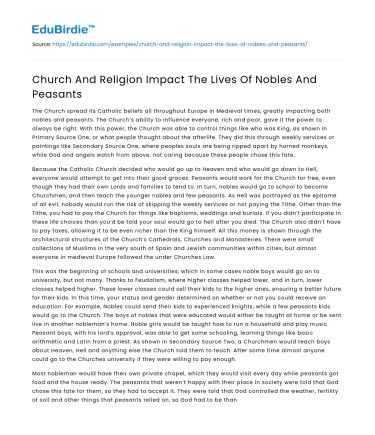The Church spread its Catholic beliefs all throughout Europe in Medieval times, greatly impacting both nobles and peasants. The Church’s ability to influence everyone, rich and poor, gave it the power to always be right. With this power, the Church was able to control things like who was King, as shown in Primary Source One, or what people thought about the afterlife. They did this through weekly services or paintings like Secondary Source One, where peoples souls are being ripped apart by horned monkeys, while God and angels watch from above, not caring because these people chose this fate.
Because the Catholic Church decided who would go up to Heaven and who would go down to Hell, everyone would attempt to get into their good graces. Peasants would work for the Church for free, even though they had their own Lords and families to tend to. In turn, nobles would go to school to become Churchmen, and then teach the younger nobles and few peasants. As Hell was portrayed as the epitome of all evil, nobody would run the risk of skipping the weekly services or not paying the Tithe. Other than the Tithe, you had to pay the Church for things like baptisms, weddings and burials. If you didn’t participate in these life choices than you’d be told your soul would go to hell after you died. The Church also didn’t have to pay taxes, allowing it to be even richer than the King himself. All this money is shown through the architectural structures of the Church’s Cathedrals, Churches and Monasteries. There were small collections of Muslims in the very south of Spain and Jewish communities within cities, but almost everyone in medieval Europe followed the under Churches Law.
Save your time!
We can take care of your essay
- Proper editing and formatting
- Free revision, title page, and bibliography
- Flexible prices and money-back guarantee
This was the beginning of schools and universities, which in some cases noble boys would go on to university, but not many. Thanks to Feudalism, where higher classes helped lower, and in turn, lower classes helped higher. These lower classes could sell their kids to the higher ones, ensuring a better future for their kids. In this time, your status and gender determined on whether or not you could receive an education. For example, Nobles could send their kids to experienced knights, while a few peasants kids would go to the Church. The boys of nobles that were educated would either be taught at home or be sent live in another nobleman’s home. Noble girls would be taught how to run a household and play music. Peasant boys, with his lord’s approval, was able to get some schooling, learning things like basic arithmetic and Latin from a priest. As shown in Secondary Source Two, a Churchmen would teach boys about Heaven, Hell and anything else the Church told them to teach. After some time almost anyone could go to the Churches university if they were willing to pay enough.
Most nobleman would have their own private chapel, which they would visit every day while peasants got food and the house ready. The peasants that weren’t happy with their place in society were told that God chose this fate for them, so they had to accept it. They were told that God controlled the weather, fertility of soil and other things that peasants relied on, so God had to be thanked. If they didn’t thank God or appreciate their status then their needs would be forgotten about. Putting the peasants in a terrible situation.
In conclusion, the Church an it’s Religion equally impacted everyone, rich or poor, Noble or Peasant, and is still impacting the way we live our lives. As seen in Secondary Source Three, an important man and his wife sit and pray, with the inscription telling others to pray too. This was made right after the Medieval Era, allowing us the knowledge to know that the Church hadn’t lost its influence. It still is one of the largest Religions today, with an impact on many, barely changing its ability to influence people centuries later.






 Stuck on your essay?
Stuck on your essay?

